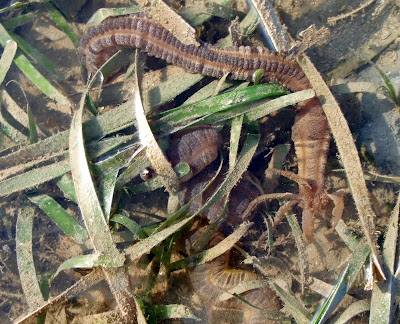Sixty Third Discovery Posting:
Besides stunning sunsets, sometimes if we go to Semakau early enough, we get to watch the wonderful sunrise too (pictures below).

 In this discovery posting, I'm going to write about a particular thing which might not get as much attention from visitors as compared to the seastars and nudibranches. Some reasons why this is so might be because it isn't colourful, it doesn't move around, one can almost certainly see it every time when they visit Semakau's inter-tidal area.
In this discovery posting, I'm going to write about a particular thing which might not get as much attention from visitors as compared to the seastars and nudibranches. Some reasons why this is so might be because it isn't colourful, it doesn't move around, one can almost certainly see it every time when they visit Semakau's inter-tidal area.So what am I going to write about? Well, seagrasses (picture below)!
 Discovery Note (Seagrasses in a glance):
Discovery Note (Seagrasses in a glance):1. They are called seagrasses because like grasses, they have roots, leaves and rhizomes (horizontal underground stems that form extensive networks below the surface).
2. But they are not true grasses and actually they are more closely related to water lilies and terrestrial plants (plants which live on the ground) such as lilies.
3. Since they are named, 'seagrasses', so it isn't strange that they can live underwater.
4. They are also the only marine flowering plants.
Discovery Note (More detailed information about seagrasses):
1. Seagrasses are commonly found on tidal mudflats in estuaries, on shallow sandy areas close to the coast, in coral reef lagoons and around sand cays.
2. They can also grow up to depths of more than 10 meters but this is limited by water clarity because they require light for photosynthesis (The process by which plants use light to 'make food' from carbon dioxide and water).
3. Seagrass can reproduce through sexual or asexual methods.
4. In sexual reproduction, the plants produce flowers and transfer pollen from the male flower to the ovary of the female flower. Most seagrass species produce flowers of a single sex on each individual, so there are separate male and female plants.
5. For asexual (or vegetative) reproduction. New ‘plants’ arise without flowering or setting seed. Seagrasses grow vegetatively by extending and branching their rhizomes in the same way that grass in a lawn grows. This allows significant areas of seagrass meadow to form from only a few
shoots.
At this point, you might start to see a bit of 'stars' from all this information or even ask, "So what? Why talk about seagrasses?" Here's why...
Discovery Note (The GOOD things about having seagrasses) :
1. They help maintain water clarity by trapping fine sediments and particles with their leaves.
2. They can stabilize the bottom with their roots and rhizomes in much the same way that land grasses retard soil erosion.
3. Seagrasses and the organisms that grow on them are food for many marine animals like the dugong (sea cow) and turtles.
4. Seagrasses which dies and have been broken down into smaller pieces also forms a part of the food chain in a marine ecosystem.
5. They are homes and nursery areas for for a vast variety of organisms including molluscs, crustaceans (prawns, shrimp and crabs) and fishes (both the kind you eat (commercial species) and the kind you like looking at (reef fishes)).
6. And so one can find lots of marine creatures amongst seagrasses if you look carefully...
Here are some of them which we saw during this trip.
A ocellated sea cucumber (picture below)
 A synaptid sea cucumber (picture below)
A synaptid sea cucumber (picture below) And seahorses also like to hide amongst seagrasses , here's one of them (picture below)
And seahorses also like to hide amongst seagrasses , here's one of them (picture below) Well, we did see many more things in this trip, to find out, you can read about
Well, we did see many more things in this trip, to find out, you can read abouta) KS's wonderful creation on his first time guiding alone at Semakau
b) RY's pictures of two seahorses
c) ST's galore of pictures
d) SY's first time as a hunter seeker at Semakau
Enjoy! =)
For discoverer's information, there is a team in Singapore whom monitors seagrasses, they are known as 'Team Seagrass', keen to learn more or go out in the field to look at seagrasses. Visit their blog @ http://teamseagrass.blogspot.com/
References:
a) http://www.reef.crc.org.au/publications/brochures/CRC_Reef_seagrass_web.pdf
b) Singapore's Team Seagrass blog
No comments:
Post a Comment